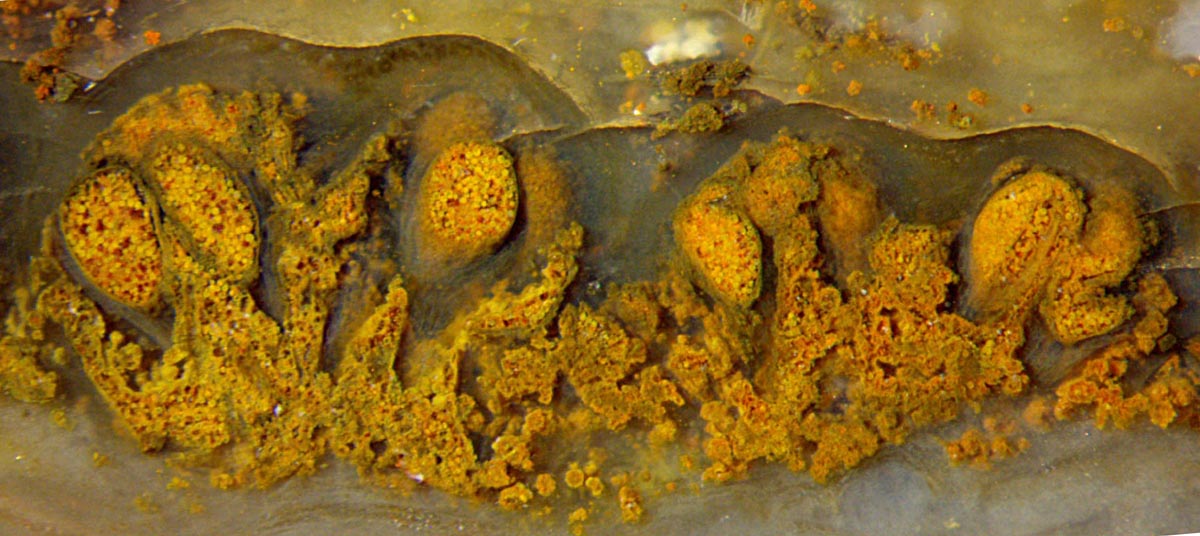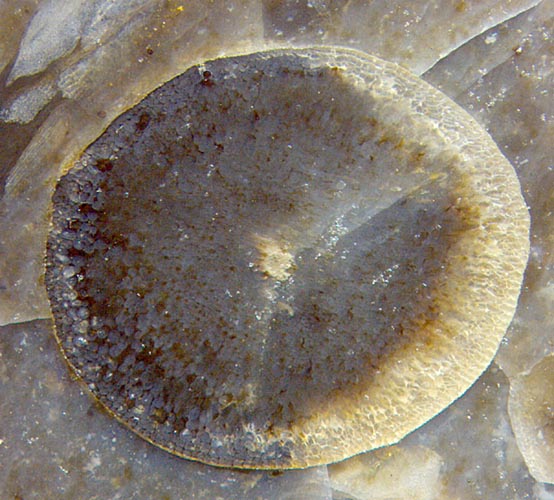Fossil plant cuticle as easy crack
path
Land
plants protect themselves against water loss with a thin cuticle
containing several wax-like substances. Plant cuticles are seldom seen
detached from the plant surface but their
existence can
be deduced from the fact that they provide easy crack paths since their
waxy composition makes a mechanical discontinuity in the chalcedony: a
face of low fracture toughness.
A crack running along this face greatly increases the mechanical
discontinuity
and creates an optical discontinuity
within the transparent chalcedony which reflects the incident light so
that the cuticle may appear as a conspicuous boundary of illumination
marking the plant surface.

Fig.1: Two pinnules of the
Permian tree fern Scolecopteris, cross-sections with sporangia, with distinct optical effect of the crack along
the cuticle on the pinnules. Image width 4.2mm.
Apparently
a crack entering from above left, driven by tensile stress,
incidentally met the cuticle
with low fracture toughness, whereupon it changed its direction and
followed the cuticle
along the curved pinnule surface until the stress intensity at the
crack tip had become so low on its downward path that propagation along
the cuticle stopped. At that point, a horizontal path provided higher
stress intensity so that the crack changed its direction again. After
having traversed some debris, it met the cuticle on the other pinnule
and followed it until it stopped again for the same reason as before:
decreasing stress intensity on the downward path. Like before, the
higher stress intensity on horizontal paths is apparent from vaguely
seen horizontal cracks on the right.

Cracks running through the chert usually but not always cross
the silicified plants.
A cuticle acting as an obstacle to thorough silicification as suggested
by the crack path in Fig.1 for Permian chert acts in the same way, as
expected, for Devonian chert as seen in Fig.2. Here, cracks
became deflected around the plant, thereby
separating it from the surrounding chalcedony, with the resulting gap
greatly increasing the visibility of the plant surface.
Fig.2: Cross-section of the early land plant Aglaophyton,
slightly inclined,
detached from the surrounding chalcedony by a crack along the cuticle. Height of the section 4mm.
Since
the cuticle itself is not easily seen, indications of its presence can
be useful in cases where one does not know whether a palaeozoic plant
is aquatic or terrestrial. This applies to the enigmatic sphere
Pachytheca,
which once had been thought to be an alga but is probably a
nematophyte. Nematophytes
include both
aquatic and terrestrial organisms, also aquatic ones adapted to
occasional drying. The deflection of cracks at Pachytheca
is apparently due to a cuticle covering the sphere.
Samples: B/51.2 (> 5.2kg), found near Bannewitz
(Doehlen basin)
in 1995;
Rh3/3.2 (0.28kg), found near
Milton of Noth (Rhynie) in 1998.
H.-J.
Weiss 2021
|
 |
 33 33 |

 33
33


 33
33